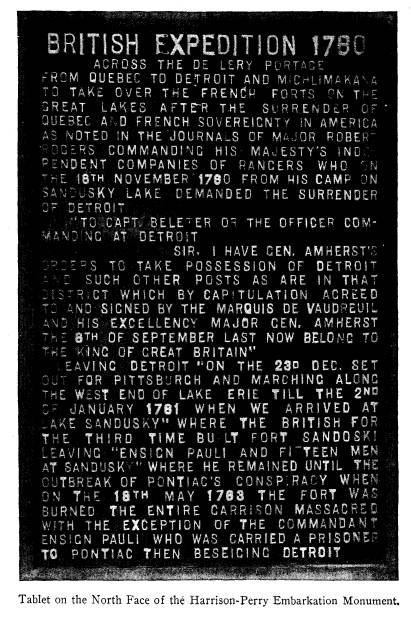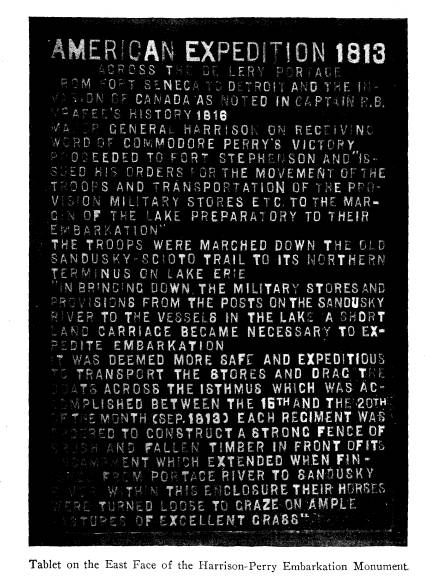Ohio History Journal
366 Ohio Arch. and Hist. Society Publications.
some on board the fleet to take their
second position nearer
Canada. They arrived a little before
sunset that day at East
Sister Island, while General Harrison
and Commodore Perry
in the Ariel, made a reconnoissance of
the enemy's coast. It
was not until the morning of the 27th,
that they began this last
journey across the lake. One account
says the day was fine and
a propitious breeze made their passage a
pleasing pastime. It
was a sublime and inspiring spectacle to
behold sixteen ships
of war and a hundred boats filled with
men borne rapidly and
majestically to the long sought shores
of the enemy, and thus
they sailed until 4 p. m., when they
landed four miles below
Malden. From this point, they marched to
Detroit, and then
on to victory at the battle of the
Thames. The battle of Lake
Erie was the first encounter of our
infant navy, in fleet and
squadron, the Guerriere, the Java, and
Macedonia had sur-
rendered in combat with single ships,
but it was on the waters
of our fair Lake Erie, that the British
nation was taught that
we could conquer them in squadron array.
The battle of Lake
Erie opened to Gen. Harrison and his
army the gate-way to
Malden, and enabled him to capture the
only army that was
taken during the war of 1812. More than
this, it restored to us
Detroit, gave our young nation once
more, free navigation of the
Great Lakes, and shielded the frontier
for 300 miles from the
assaults of the torch of a British and
savage foe. Mr. Chairman,
the National Society, the United States
Daughters of the War
of 1812, State of Ohio, presents with
great pleasure, for safe-
keeping, this tablet with the patriotic
hope that those who pass
by in future years, will stop and read
of the brave men and their
deeds recorded hereon, and cherish anew
love of liberty and
free government which made this a
nation, and has always
kept it such. This tablet marks the
nothern terminus of Ohio's
famous Harrison trail-a historic spot
indeed in the history of
this republic.
PROF. G. F. WRIGHT'S ADDRESS.
Ladies and Gentlemen, we are standing
upon one of the
most interesting spots connected with
American history. From
the middle of the eighteenth century to
the close of the War of
|
Old Fort Sandoski and the De Lery Portage. 367 |
|
|
368 Ohio Arch. and Hist. Society Publications.
1812 this portage leading from the head
of Sandusky Bay across
the neck of Marblehead Peninsula to the
open waters of Lake
Erie figured largely in the struggle of
two great European pow-
ers for the possession of the vast realm
lying west of the Alle-
gheny mountains. It was here, also, that
the Indian tribes made
their last great effort to
maintain their possession of the country,
and that the United States concentrated
its last force which
completed Perry's victory and closed the
War of 1812. Such
deeds as were here transacted deserve
commemoration, and it
is fitting that we should here erect
monuments to remind our
children and children's children of the
price that has been paid
for the inheritance which they possess
in these broad and fertile
fields, in these lines of communication
open to them both by land
and water, and in the free political
institutions under which they
enjoy without restriction life, liberty
and the pursuit of happiness.
It is but two miles across this neck of
land separating the
upper part of Sandusky Bay from the
waters of Lake Erie. To
make the circuit by water one must
travel fifty miles. With only
the primitive boats of 150 years ago the
navigation of these fifty
miles was beset with many hazards. There
had then been no
accurate soundings of the channel, so
that unknown shoals where
in storms the breakers were high
rendered the rounding of Mar-
blehead a dangerous procedure. So it
came about that the In-
dians coming from Detroit and the upper
lakes on their way to
the Ohio river preferred to make this
portage rather than to
consume the time required in making the
entire circuit by water
and at the same time free
themselves from the hazards of that
voyage.
Following them, the French and the
Americans pursued the
same course in all their military
expeditions. The English alone
pursued the other course, as in the
expeditions of Proctor to
capture Fort Stephenson, at the lower
falls of the Sandusky
river, where Fremont now stands.
In 1745 the first fort built by white men in Ohio, known
as old Fort Sandoski, was erected on
this spot by English trad-
ers, who were conspiring with the famous
Wyandot chief Nicolas
to drive the French from Detroit and all
the upper posts. The
conspiracy, like that of Pontiac a
little later, failed through the
|
Old Fort Sandoski and the De Lery Portage. 369 |
|
|
|
Vol. XXI - 24. |
370 Ohio Arch. and Hist. Society Publications.
treachery of one of the followers of
Nicolas-in this case a
woman. In 1748 old Fort Sandoski was
destroyed, and both
the Indians and the English took their
departure.
The English traders, however, soon
returned, which led the
French to send a formidable force to
establish their possessions
along the south shore of Lake Erie and
onward to the Ohio
river. In 1754 the French built Fort
Junundat, on the opposite
side of Sandusky Bay from old Fort
Sandoski. This was the
work of the distinguished engineer de
Lery, who, skirting along
the southern shore of Lake Erie, entered
Sandusky bay and
reached old Fort Sandoski on Sunday,
August 4, 1754. In fur-
ther pursuit of his journey he made a
portage of two miles to
"the great lake" at the
present site of Port Clinton.
After the capture of Fort Duquesne by
the British in 1758,
and Wolfe's victory on the Plains of
Abraham at Quebec in
1759, Canada with all its dependencies
was surrendered to the
British crown, but it still remained to
carry into effect the full
terms of the conquest by taking over the
western forts. The
commission for the occupation of old
Fort Sandoski and the
opening of the trail to the Ohio river
was executed by the notori-
ous Major Robert Rogers, leaving Ensign
Pauli and fifteen men
at Fort Sandoski to complete the work in
1761. In 1763 Fort
Sandoski was the first to fall as the
result of the conspiracy of
Pontiac. All the garrison was massacred
except Ensign Pauli,
who was carried as a prisoner to
Detroit, where he made his es-
cape. About the same time a party of
ninety-six men under
Lieutenant Cuyler was sent out to
relieve Detroit, but was in-
tercepted on the way, and the most of
them killed, the Lieutenant,
however, with thirty men, managed to
escape and to reach Fort
Sandoski only to find it in ashes. Two
months later, on the 26th
of July, a detachment of 260 men under
the command of Captain
Dalyell arrived at the ruins of the old
fort, and, furious at the
spectacle, came up to the falls of
Sandusky-now Fremont-
to avenge the massacre and destroyed the
Wyandot village at
that place.
In 1764 Colonel Bradstreet, accompanied
by Israel Putnam
and 1,183 men, visited old Fort Sandoski
and paused for a little
rest. While there he made an unfortunate
agreement with the
Old Fort Sandoski and the De Lery
Portage. 371
Indians which eventually led to his
dismissal from the service.
His distinguished engineer, Montresor,
was left to rebuild the
fort, which, however, was only partially
accomplished.
There is not much more recorded
concerning the portage
of old Fort Sandoski until the War of
1812, when, after the
victory of Commodore Perry, on September
10, 1813, General
Harrison, with his entire army, moved
down from his head-
quarters at Fort Seneca, on the Sandusky
river, first to Fort
Stephenson at Fremont, and then to the
old portage from Fort
Sandoski, at Port Clinton. Here,
following the example of
the French expeditions of earlier times,
he hauled his vessels
and his supplies across the famous de
Lery portage, where we
now stand, ready to transport his army
for a final conflict on the
banks of the Thames. He constructed a
fence across this pen-
insula in order to confine the thousands
of horses connected
with his command, until he should return
from his expedition
across the lake. Within the Marblehead
peninsula, thus inclosed,
he turned loose the horses to be guarded
by a small force until
his return. After the battle upon the
Thames the victorious
army returned to Port Clinton, gathered
up their horses and sup-
plies and joyfully started upon their
homeward journey.
Thus it will be seen that my opening
remarks were amply
justified by the facts. The deeds here
recorded deserve to be
imprinted upon the memory of every
citizen of Ohio. They
should be reiterated in the presence of
our children at home, and
should be incorporated into the
text-books prepared for the in-
struction of schools. As a slight effort
to perpetuate their
memory, we erect these monuments, and
leave to future gen-
erations the record engraved upon these
tablets. May no care-
less hand ever deface them, and no
ruthless hand ever do them
violence.
MR. RICHARDSON'S ADDRESS.
This is a day for memory, when our thoughts
revert to other
times and scenes. We stand today upon
historic ground. In
the breezes there once floated over this
spot the milk-white ban-
ner of Navarre, bespangled with the
golden lilies of the Bourbon
house. Here, too, floated the meteor
flag of England-the cross

